Agenda vs Planner: What's the Difference?
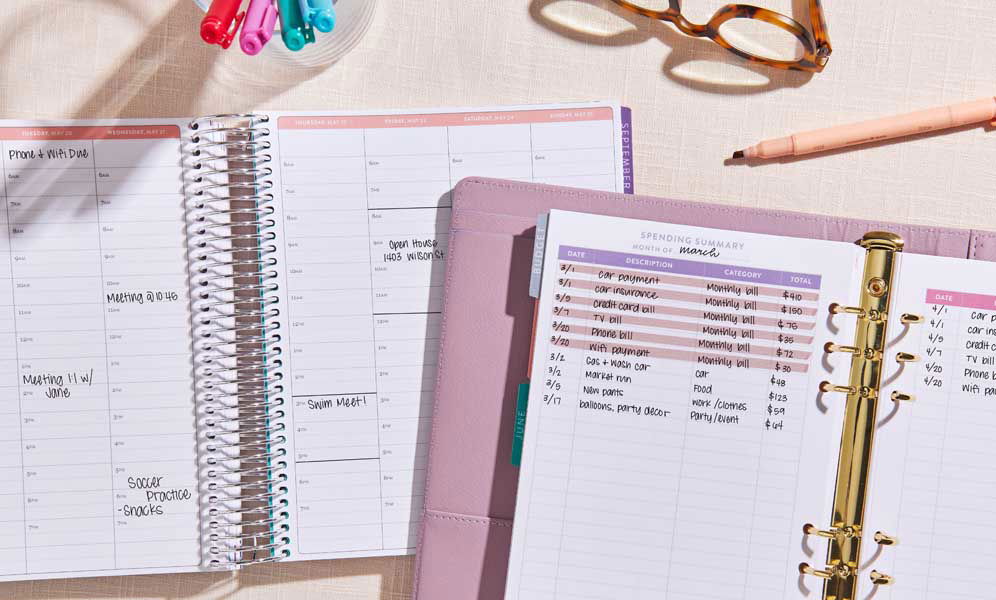
As organization enthusiasts who thrive on the tangible satisfaction of paper planners, we’re here to answer any questions you may have on the discrepancies between agendas and planners. With a passion for stress management, time allocation, and routine establishment, we’ve found that understanding these distinctions can profoundly impact productivity and peace of mind.
Key Differences Between an Agenda and a Planner
When it comes to scheduling and organization, it's essential to understand the fundamental differences between agendas and planners. So, let’s break it down:
Scope of Use
An agenda typically focuses on recording appointments, events, and deadlines within a predetermined timeframe, often spanning days, weeks, or months. While a planner often includes the scope of use for agendas, it also encompasses a broader spectrum of organizational tools, including goal-setting sections, habit trackers, and space for personal notes and reflections.
Flexibility
Agendas are primarily rigid in structure, with designated spaces for each day or week, limiting the ability to customize layouts according to individual preferences. Planners, on the other hand, are books that offer the difference of greater flexibility, allowing users to tailor layouts, sections, and content to suit their unique needs and preferences.
Portability
The size of agendas tend to be compact and lightweight, making them ideal for on-the-go scheduling and as quick references. The size of planners, while still portable, may feature the difference of additional pages and sections that contribute to a slightly bulkier design.
Format
Agendas commonly feature the difference of a straightforward layout, typically displaying dates and times in a linear fashion, often with minimal embellishments or extras. Planners, however, are books that incorporate diverse formats, such as monthly calendars, weekly spreads, daily planner layouts, and goal-tracking pages, catering to various organizational preferences and styles.
Common Features of an Agenda
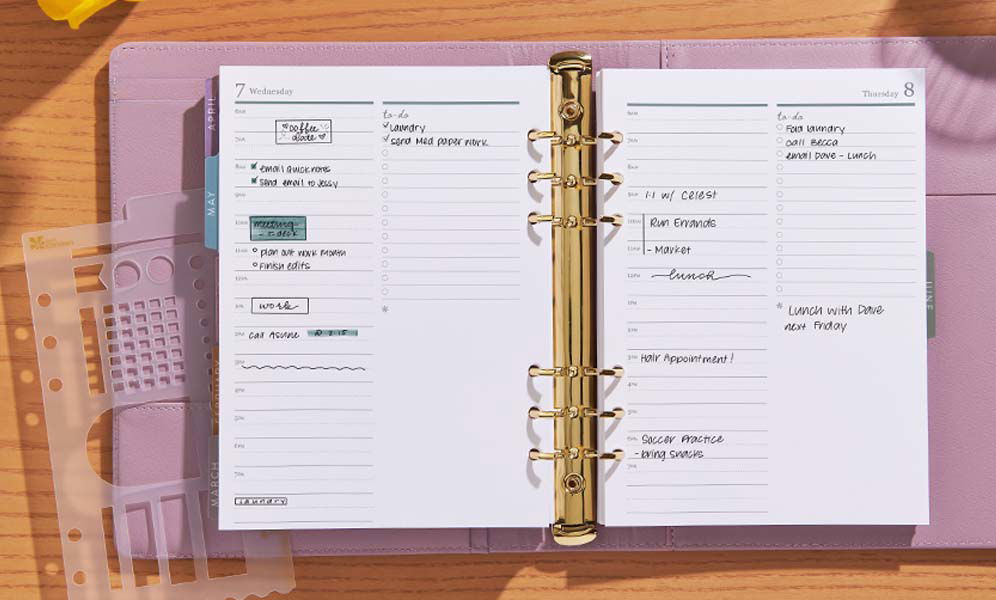
Agendas are streamlined tools crafted specifically for efficient scheduling and time management. Here are some typical features you'll find in an agenda:
Date-Specific Pages
Agendas are structured around date-specific pages, providing a clear and concise layout for recording appointments, deadlines, and other commitments. Each page typically represents a day, week, or month, allowing users to organize their schedules with precision.
Time Slots for Scheduling
Agendas often include designated time slots for scheduling appointments and tasks throughout the day. These time slots provide a structured framework for planning activities and managing time effectively, ensuring that each commitment is allocated the appropriate amount of time.
To-Do Lists or Notes Sections
Many agendas feature space for notebook or journal inserts that let you jot down to-do lists, notes, or reminders. These notebook or journal sections allow users to capture important information, prioritize tasks, and track progress on various projects or responsibilities.
Clear Layout and Design
Agendas are known for their minimalist and intuitive design, prioritizing functionality and clarity. With clean layouts and straightforward formats, agendas make it easy to navigate through daily schedules and reference important information at a glance.
Learn more about How to Create Your Own Agenda Planner.
Common Features of a Planner
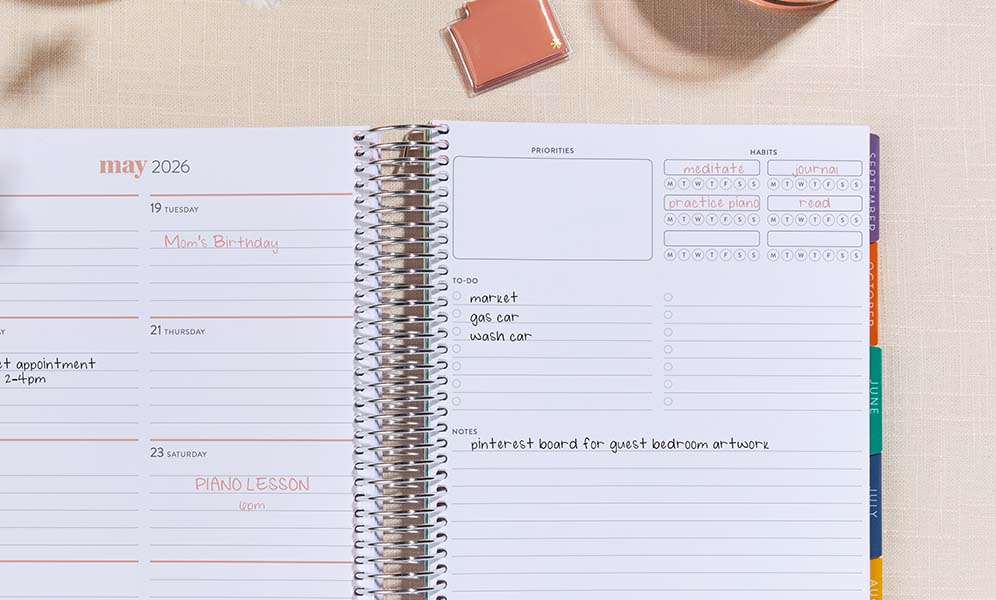
Planners are versatile tools designed to accommodate various organizational needs and preferences. Here are some key features commonly found in planners:
Monthly and Weekly Calendars
Planners typically include monthly and weekly calendar spreads, providing users with a comprehensive view of their schedules. These calendar pages allow for long-term and short-term planning, making it easy to schedule appointments, set deadlines, and track important events.
Learn all about Daily, Weekly, Monthly Planning Tips.
Goal-Setting Sections
Many planners feature dedicated sections for goal setting and tracking. These sections may include prompts for defining goals, action plans for achieving them, and trackers for monitoring progress over time. Goal-setting sections empower users to clarify their objectives, stay focused on their priorities, and measure their success along the way.
Habit Trackers
Planners often include habit-tracker pages or sections where users can monitor their daily routines and behaviors. Habit trackers enable users to establish and track progress toward new habits or goals, such as exercise, hydration, mindfulness, or productivity habits. By visually recording their habits over time, users can identify patterns, stay accountable, and cultivate positive behaviors.
Blank Pages for Notes and Reflections
Planners frequently include blank pages or sections for journaling, jotting down notes, brainstorming ideas, or reflecting on experiences. These blank pages provide space for creativity, personalization, and self-expression within the planner. Users can use these pages to capture thoughts, sketch out plans, or document memorable moments, adding depth and personality to their planning process.
Customizable Layouts
Many planners offer customizable layouts and formats to suit individual preferences, situations, and organizational styles. Users can choose planners with different page designs, such as vertical, horizontal, or hourly layouts, depending on their scheduling preferences. Some planners also allow for additional customization options, such as interchangeable covers, refillable inserts, or modular add-on sections.
Learn more about How to Organize Your Planner in 11 Simple Steps.
When to Use an Agenda
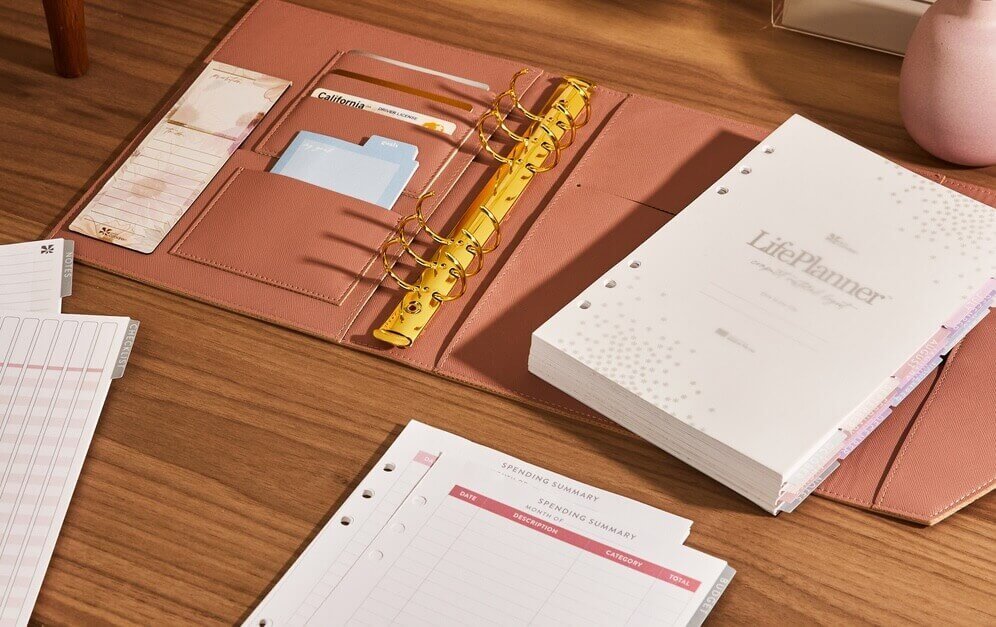
An agenda planner can benefit a wide range of busy, daily and weekly schedules. They are great organizational tools for specific needs and time-sensitive commitments. An agenda is usually helpful in the following scenarios:
Scheduling Meetings
Agenda planners excel at efficiently managing appointments, ensuring that every commitment runs smoothly. With designated spaces for each day or week, agendas provide a clear overview of available time slots, making it easy to schedule meetings and appointments without overlapping commitments.
Additionally, the linear format of agendas allows for seamless coordination with colleagues or clients, facilitating effective communication and planning. Whether arranging a quick catch-up or setting up a formal presentation, agenda planners streamline the process of scheduling meetings, minimizing confusion and maximizing productivity.
Planning Events
From birthdays to business conferences, agendas provide a clear framework for coordinating schedules and logistics. Agendas are indispensable tools for planning events of all scales, from intimate gatherings to large-scale conferences. With their linear layout and clear structure of dates and times, agendas provide a comprehensive framework for event planning. Users can easily allocate time slots for various aspects of event coordination, including venue selection, guest invitations, program scheduling, and logistical arrangements.
Additionally, the portability of agendas ensures that event planners can access vital information on the go, whether liaising with vendors, confirming details with participants, or troubleshooting unforeseen challenges. By harnessing the organizational power of agendas, event planners can execute flawless events while minimizing stress and maximizing efficiency.
Alleviating Overwhelm
Agendas serve as effective tools for breaking down overwhelming tasks into manageable steps, helping promote a sense of control and reducing stress. By providing designated spaces for daily or weekly planning, agendas empower users to prioritize tasks, set realistic goals, and allocate time efficiently.
Not to mention the act of writing down commitments and deadlines can help declutter the mind, freeing up mental space for focused work and creative problem-solving. Learn more about The Power of Pen and Paper in the Age of AI.
Whether tackling a busy workday or juggling personal responsibilities, the structured format of agendas offers a tangible roadmap for navigating through challenging times with confidence and composure.
When to Use a Planner

Planners are indispensable companions for those seeking comprehensive organization and goal achievement. You may question your current system or just want to know more about using a planner efficiently. If you’re curious about either, keep reading to know where they shine brightest:
Personal Organization
Whether it's tracking fitness progress, planning meals, or managing finances, planners offer a holistic approach to personal organization. With dedicated sections for various aspects of life, they serve as centralized hubs for managing day-to-day tasks and long-term goals.
Goal Setting
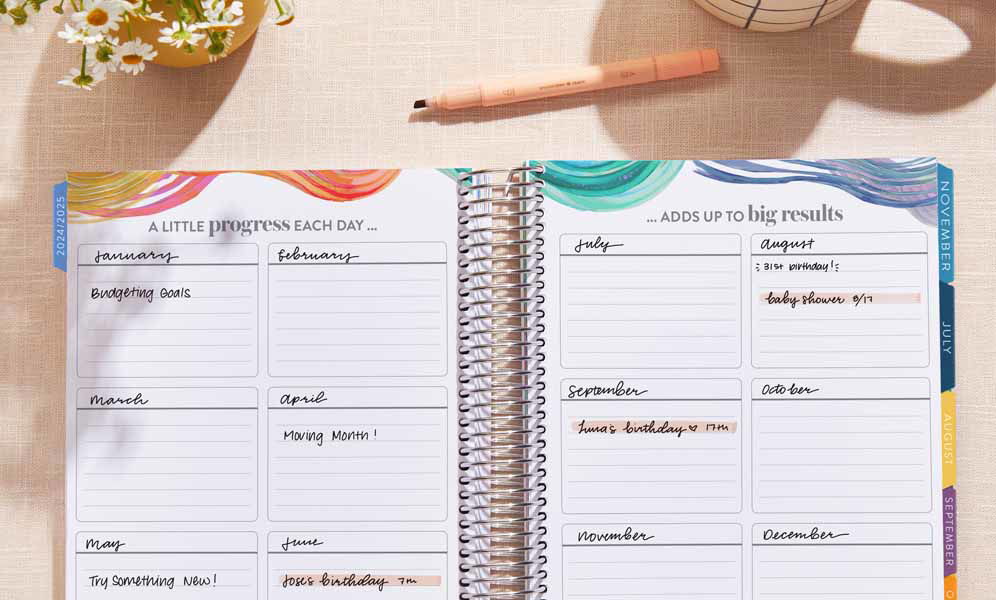
Planners provide purpose-driven spaces for setting actionable goals, tracking progress, and celebrating achievements. By integrating goal-setting frameworks and progress trackers, they inspire motivation and accountability, propelling users toward success.
Time Management
With structured layouts and designated spaces for prioritizing tasks and allocating time, planners empower users to optimize their schedules and enhance productivity. Whether navigating busy workdays or balancing multiple commitments, planners facilitate efficient time management strategies tailored to individual needs and preferences.
Learn more about Using a Planner: Benefits, Tips, and Ideas for Beginners and Mastering Time Management and Productivity: 11 Tips for Success.
How to Choose Between a Planner and an Agenda
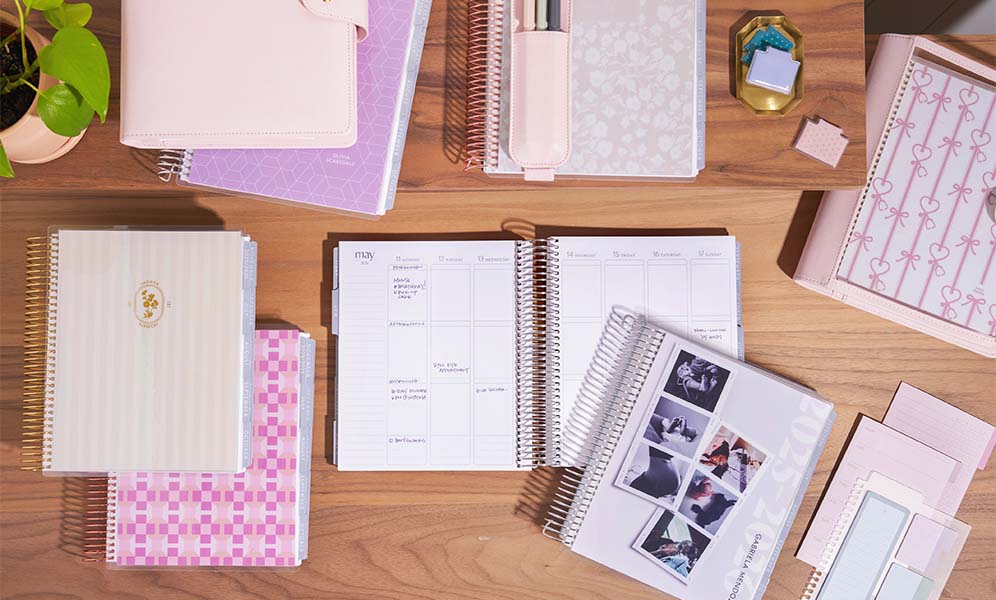
Selecting the right organizational tool can significantly impact your productivity and satisfaction with your planning process. Explore our best planners (including agenda planners) to discover one that’s right for you. And below, we’ve outlined a guide to help you navigate the decision between a planner and an agenda:
Analyze Your Needs
Start by evaluating your organizational requirements. Consider the scope of your scheduling, goal-setting, and personal management needs. If you primarily need a tool for scheduling appointments and managing deadlines, an agenda should do it. However, if you seek a more comprehensive system for personal organization and goal achievement, a planner is the smarter option.
Consider the Level of Detail and Organization Required
Reflect on the level of detail and organization you prefer in your planning process. Are you someone who thrives on structured scheduling with designated time slots and clear deadlines? Or do you prefer a more flexible approach with customizable layouts and additional organizational features? A planner offers scheduling plus flexibility and customization options, while an agenda provides a straightforward layout focused on scheduling.
Evaluate Your Planning Style
Think about your planning style and how you prefer to organize your tasks and commitments. Do you prefer a linear approach, where each day or week is mapped out in chronological order? Or do you prefer a more holistic approach, where you can integrate goal-setting, habit-tracking, and personal reflections into your planning process? Consider whether you prefer the simplicity and order of an agenda or the versatility and depth of a planner.
Learn more about 11 Different Planner Types Explained + How to Choose and How to Start Planning + 15 Tips to Start a Planner.
Whether you opt for an agenda's simplicity or a planner's versatility, prioritizing organization and time management is key to achieving your goals and managing stress. By understanding the differences between these organizational tools and selecting the option that best aligns with your needs and preferences, you can embark on a journey toward greater productivity and peace of mind.

You may also enjoy Planner vs. Calendar: Choosing the Perfect Tool for Your Needs.